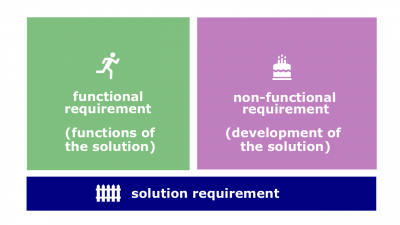Difference between revisions of "Solution requirement"
(→Related coursework) |
|||
| Line 10: | Line 10: | ||
*[[Business requirement]]. A higher level business rationale that, when addressed, will permit the organization to increase revenue, avoid costs, improve service, or meet regulatory requirements. | *[[Business requirement]]. A higher level business rationale that, when addressed, will permit the organization to increase revenue, avoid costs, improve service, or meet regulatory requirements. | ||
| − | ==Related | + | ==Related lectures== |
*[[Business Analysis Quarter]]. | *[[Business Analysis Quarter]]. | ||
[[Category: Septem Artes Administrativi]][[Category: Articles]] | [[Category: Septem Artes Administrativi]][[Category: Articles]] | ||
Revision as of 12:27, 4 January 2019
Solution requirement (hereinafter, the Requirement) is a characteristic of a solution that meets the business and stakeholder requirements. May be subdivided into functional and non-functional requirements.
Types
- Functional requirement. Any requirement that refers to the product capabilities. In other words, a functional requirement describes what the product must do for its users. In systems engineering, a functional requirement is a particular behavior or metric to judge the operation of a system.
- Non-functional requirement(s). The quality attributes, design and implementation constraints, and external interfaces that the product must have.
- Technical requirement. A set of technical properties that a product must fulfill.
- Transition requirement(s). A classification of requirements that describe capabilities that the solution must have in order to facilitate transition from the current state of the enterprise to the desired future state, but that will not be needed once that transition is complete.
Related concepts
- Business requirement. A higher level business rationale that, when addressed, will permit the organization to increase revenue, avoid costs, improve service, or meet regulatory requirements.
